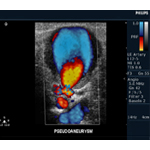Arterial Duplex Imaging


Peripheral arterial disease is estimated to affect upwards of 8 to12 million people in the United States alone. Originally, the purpose of the noninvasive arterial evaluation was to offer objectivity in the diagnosis of lower extremity arterial disease. It was intended to complement but not to replace a careful history and physical examination of the patient. Currently, after decades of evolution, the noninvasive arterial evaluation may be tailored to a patient's specific needs, depending on the clinical presentation and the pathologic findings being evaluated.
Arterial Duplex Imaging can provide the healthcare provider with anatomic and physiologic information, but it does not provide information concerning the overall hemodynamics of the limb. Arterial Duplex imaging can diagnose aneurysms and pseudoaneurysms in the extremities. Duplex imaging can distinguish between stenosis and an occlusion. It can determine the length of the diseased segment and the patency of the distal vessels. Arterial Duplex is also used to evaluate the vessels post intervention (angioplasty and stent placement) and assists the healthcare provider in monitoring the patient's postoperative care by continuing surveillance of the bypass graft.
